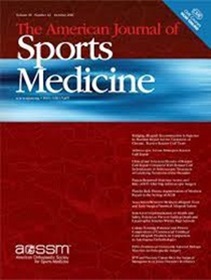青少年首次接触美式足球的年龄与健康的社区居住成年人晚年健康问题之间的关系。
IF 9.3
1区 医学
Q1 SPORT SCIENCES
引用次数: 0
摘要
几项研究表明,前职业运动员首次接触美式足球(Football)的年龄较低与晚年健康问题有关;然而,对业余(即非专业)运动员的研究就不那么清楚了。目的:本研究对前美国业余橄榄球运动员进行队列研究,评估AFE是否与以下因素有关:(1)精神和神经行为症状,(2)认知困难,(3)一般健康问题,(4)运动症状,(5)功能状态。方法采用ResearchMatch平台进行横断面调查研究。关键的自变量是首次接触足球的年龄(AFE < 12 vs AFE≥12)。主要结局包括抑郁症状(患者健康问卷-9;PHQ-9),焦虑症状(广泛性焦虑障碍-7;GAD-7),认知困难(不列颠哥伦比亚省认知投诉量表;BC-CCI),神经行为症状量表(NSI)评分,以及其他健康问题的患病率。多变量回归评估AFE与结果变量之间的关联。结果共有107名接触足球的男性参与者(平均年龄:60.6±15.1岁)报告了平均4.2±2.7年的足球接触,平均AFE为11.7±3.1年。在多变量分析中,AFE < 12不是PHQ-9(非标准化beta, B: 0.51,标准误差,SE: 1.25, p = 0.682)、GAD-7 (B: 0.09, SE: 0.95, p = 0.926)、NSI (B: - 0.56, SE: 2.93, p = 0.850)或BC-CCI (B: - 0.65, SE: 0.77, p = 0.403)的显著预测因子。然而,更多的既往脑震荡与较差的PHQ-9 (B: 0.44, SE: 0.10, p < 0.001)、GAD-7 (B: 0.33, SE: 0.07, p < 0.001)、NSI (B: 1.04, SE: 0.23, p < 0.001)和BC-CCI评分(B: 0.26, SE: 0.06, p < 0.001)相关。AFE < 12不能预测一般健康问题或独立功能状态。结论:在年轻的前业余美式橄榄球运动员中,橄榄球安全与不良的精神、认知、神经行为或一般健康结果无关。然而,更多的终身脑震荡与不良的认知和精神健康结果相关。未来的研究应该在有更多合并症的老年人群中检查类似的结果,以进一步减少一般健康和晚年症状缺乏之间的潜在混淆。本文章由计算机程序翻译,如有差异,请以英文原文为准。
The Association Between Age of First Exposure to American Football at a Young Age and Later-Life Health Issues in Healthy, Community-Dwelling Adults.
INTRODUCTION
Younger age of first exposure (AFE) to American Football (football) is associated with later-life health problems among former professional athletes in several studies; however, studies examining amateur (i.e., nonprofessional) athletes are less clear.
OBJECTIVE
In a cohort of former amateur American Football players, this study assessed whether AFE to football was associated with: (1) psychiatric and neurobehavioral symptoms, (2) cognitive difficulties, (3) general health problems, (4) motor symptoms, and (5) functional status.
METHODS
A cross-sectional survey study was conducted using the ResearchMatch platform. The key independent variable was age of first exposure to football (AFE < 12 versus AFE ≥ 12). Main outcomes included depressive symptoms (Patient Health Questionnaire-9; PHQ-9), anxiety symptoms (Generalized Anxiety Disorders-7; GAD-7), cognitive difficulties (British Columbia Cognitive Complaints Inventory; BC-CCI), Neurobehavioral Symptom Inventory (NSI) score, and prevalence of other health problems. Multivariable regressions were assessed for associations between AFE and outcome variables.
RESULTS
In total, 107 male participants with exposure to football (mean age: 60.6 ± 15.1 years) reported an average of 4.2 ± 2.7 years of exposure to football, with an average AFE of 11.7 ± 3.1 years. In multivariable analyses, AFE < 12 was not a significant predictor of PHQ-9 (unstandardized beta, B: 0.51, standard error, SE: 1.25, p = 0.682), GAD-7 (B: 0.09, SE: 0.95, p = 0.926), NSI (B: - 0.56, SE: 2.93, p = 0.850), or BC-CCI (B: - 0.65, SE: 0.77, p = 0.403). However, more prior concussions were associated with worse PHQ-9 (B: 0.44, SE: 0.10, p < 0.001), GAD-7 (B: 0.33, SE: 0.07, p < 0.001), NSI (B: 1.04, SE: 0.23, p < 0.001), and BC-CCI scores (B: 0.26, SE: 0.06, p < 0.001). AFE < 12 did not predict general health problems or independent functional status.
CONCLUSIONS
AFE to football was not associated with adverse psychiatric, cognitive, neurobehavioral, or general health outcomes among young, former amateur American Football players. However, more lifetime concussions were associated with adverse cognitive and psychiatric health outcomes. Future studies should examine similar outcomes in older cohorts with more comorbidities to further minimize potential confounding between general health and lack of later-life symptoms.
求助全文
通过发布文献求助,成功后即可免费获取论文全文。
去求助
来源期刊

Sports Medicine
医学-运动科学
CiteScore
18.40
自引率
5.10%
发文量
165
审稿时长
6-12 weeks
期刊介绍:
Sports Medicine focuses on providing definitive and comprehensive review articles that interpret and evaluate current literature, aiming to offer insights into research findings in the sports medicine and exercise field. The journal covers major topics such as sports medicine and sports science, medical syndromes associated with sport and exercise, clinical medicine's role in injury prevention and treatment, exercise for rehabilitation and health, and the application of physiological and biomechanical principles to specific sports.
Types of Articles:
Review Articles: Definitive and comprehensive reviews that interpret and evaluate current literature to provide rationale for and application of research findings.
Leading/Current Opinion Articles: Overviews of contentious or emerging issues in the field.
Original Research Articles: High-quality research articles.
Enhanced Features: Additional features like slide sets, videos, and animations aimed at increasing the visibility, readership, and educational value of the journal's content.
Plain Language Summaries: Summaries accompanying articles to assist readers in understanding important medical advances.
Peer Review Process:
All manuscripts undergo peer review by international experts to ensure quality and rigor. The journal also welcomes Letters to the Editor, which will be considered for publication.
 求助内容:
求助内容: 应助结果提醒方式:
应助结果提醒方式:


